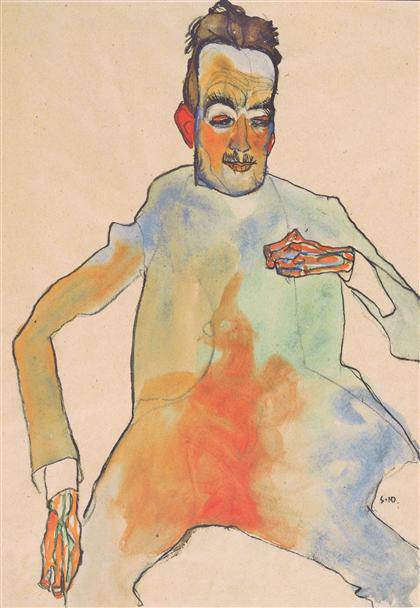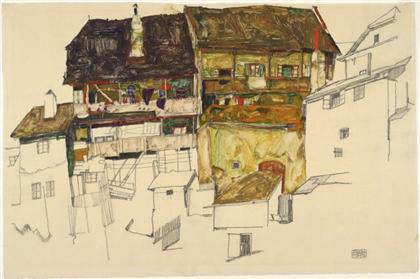
Egon Schiele (1890-1918)
The Cellist, 1910
Black chalk, watercolor on packing paper
44.7 x 31.2 cm
Albertina, Vienna, inv. no. 31178

Egon Schiele (1890-1918)
Old Houses in Krumau, 1914
Opaque color and pencil on Japanese vellum
32.5 x 48.5 cm
Albertina, Vienna, inv. no. 31158
Egon Schiele, from Albertina to Guggenheim Bilbao Guggenheim Bilbao presents a sweeping vision of the creative universe of Egon Schiele -one of the 20th century’s most important artists- through approximately one hundred drawings, gouaches, watercolors, and photographs from the Albertina Museum, Vienna.
October 2, 2012 – January 6, 2013.
]]>
Source: Guggenheim Bilbao
This show offers a unique perspective on Schiele’s stylistic evolution over the course of an intensely prolificdecade, cut short by his untimely death at the age of 28, which underscores the decisive role that thisartist’s graphic work played in shaping the history of art and consolidating his own international reputation.
Covering every stage of his career—the early pieces produced while studying at the Academy of Fine Arts,Vienna, works heavily influenced by Gustav Klimt and Viennese Modernism, and the output of his finalyears in which he made a break with naturalism, characterized by a radical use of color and new, unsettlingmotifs such as explicitly erotic nudes or portraits of children—Egon Schiele is a singular, fascinating reviewof the oeuvre of an artist who revolutionized art history.
In his tragically short life and barely ten years of independent artistic activity (1908–1918), Egon Schieleproduced a surprisingly rich artistic legacy comprising over 2,500 works on paper and more than 330paintings on panel or canvas, not to mention his sketchbooks. Unlike Gustav Klimt (1862–1918), whosedrawings served as rough drafts or sketches for his paintings, Egon Schiele treated his works on paper asindependent works of art. Indeed, his works on paper show greater freedom and expressiveness than hispictorial output.
Egon Schiele developed a highly personal, characteristic technique thanks to his decorative use of flatsurfaces and the flowing ornamental lines of the Viennese Secession style. The expressionistic bodylanguage, gestures and mimicry seen in his work was inspired by medical photographs which documentedwomen suffering from hysteria, patients of Dr. Jean-Martin Charcot’s Parisian clinic at the Salpêtrière, andby the erotic photography produced in Otto Schmidt’s studio. In his creations, Schiele returned the femalenude and other themes such as the ailing body or the pathological disintegration of personality to a newand different limelight on the stage of art. Schiele’s work was also influenced by theosophy and Spiritism aswell as ghost photographs, which he viewed as evidence of our own mortality. For example, many of hisfigures are surrounded by white halos or auras, the “light that comes out of all bodies”.
Related content
Egon Schiele’s women at Richard Nagy London (exhibition, 2011)
Follow us on:


